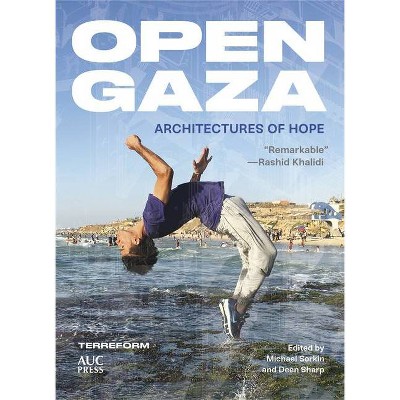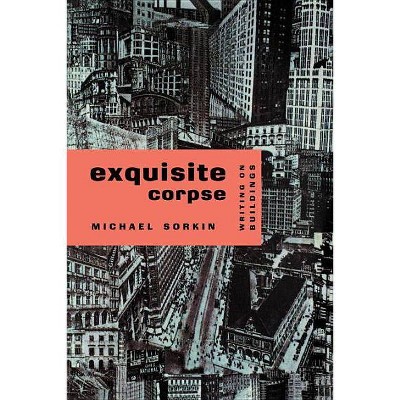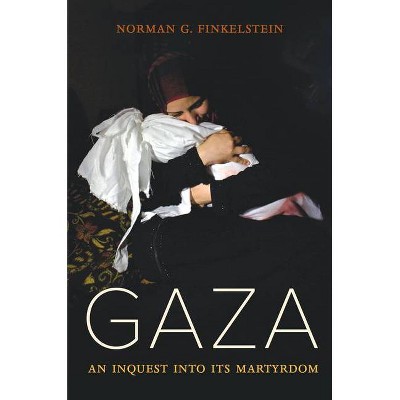Open Gaza - by Michael Sorkin & Deen Sharp (Hardcover)

Similar Products
Products of same category from the store
AllProduct info
<p/><br></br><p><b> About the Book </b></p></br></br>"The Gaza Strip is one of the most beleaguered envrionments on earth. Crammed into a space of 139 square miles (360 square kilometers), 1.8 million people live under an Israeli siege, enforcing conditions that continue to plummet to ever more unimaginable depths of degradation and despair. Gaza, however, is more than an endless encyclopedia of depressing statistics. It is also a place of fortitude, resistance, and imagination; a context in which inhabitants go to remarkable lengths to create the ordinary conditions of the everyday and to reject their exceptional status. Inspired by Gaza's inhabitants, this book builds on the positive capabilities of Gazans. It brings together environmentalists, planners, activists, and scholars from Palestine and Israel, the US, the UK, India, and elsewhere to create hopeful interventions that imagine a better place for Gazans and Palestinians. Open Gaza engages the Gaza Strip within and beyond the logics of siege and warfare, it considers how life can be improved inside the limitations imposed by the Israeli blockade, and outside the idiocy of violence and warfare"--<p/><br></br><p><b> Book Synopsis </b></p></br></br><p><b>Cutting-edge analysis on how to improve life inside the Gaza Strip through architecture and design, illustrated in full-color</b></p> <p>The Gaza Strip is one of the most beleaguered environments on earth. Crammed into a space of 139 square miles (360 square kilometers), 1.8 million people live under an Israeli siege, enforcing conditions that continue to plummet to ever more unimaginable depths of degradation and despair. Gaza, however, is more than an endless encyclopedia of depressing statistics. It is also a place of fortitude, resistance, and imagination; a context in which inhabitants go to remarkable lengths to create the ordinary conditions of the everyday and to reject their exceptional status. Inspired by Gaza's inhabitants, this book builds on the positive capabilities of Gazans. It brings together environmentalists, planners, activists, and scholars from Palestine and Israel, the US, the UK, India, and elsewhere to create hopeful interventions that imagine a better place for Gazans and Palestinians. <i>Open Gaza </i>engages the Gaza Strip within and beyond the logics of siege and warfare, it considers how life can be improved inside the limitations imposed by the Israeli blockade, and outside the idiocy of violence and warfare.</p> Contributors Affiliations <li><b>Salem Al Qudwa</b>, Harvard Divinity School and Harvard Kennedy School, Cambridge, USA<br> <li><b>Hadeel Assali</b>, Columbia University, USA<br> <li><b>Tareq Baconi</b>, International Crisis Group, Brussels, Belgium<br> <li><b>Teddy Cruz</b>, University of California-San Diego, USA<br> <li><b>Fonna Forman</b>, University of California-San Diego, USA<br> <li><b>M. Christine Boyer</b>, Princeton University, Princeton, USA<br> <li><b>Alberto Foyo</b>, architect, New York, USA<br> <li><b>Nasser Golzari</b>, Westminster University, London, UK<br> <li><b>Yara Sharif</b>, Westminster University, London, UK<br> <li><b>Denise Hoffman Brandt</b>, City College of New York, USA<br> <li><b>Romi Khosla</b>, architect, New Delhi, India<br> <li><b>Craig Konyk</b>, Kean University, Union, NJ, USA<br> <li><b>Rafi Segal</b>, Massachusetts Institute of Technology, Boston, USA <br> <li><b>Chris Mackey</b>, Payette Architects, Boston, USA<br> <li><b>Vyjayanthi V. Rao</b>, Terreform, New York, USA<br> <li><b>Sara Roy</b>, Harvard University, Cambridge, USA<br> <li><b>Mahdi Sabbagh</b>, architect, New York, USA<br> <li><b>Meghan McAllister</b>, architect, San Francisco Bay Area, USA<br> <li><b>Deen Sharp</b>, London School of Economics, UK<br> <li><b>Malkit Shoshan</b>, Harvard University, Cambridge, USA<br> <li><b>Pietro Stefanini</b>, University of Edinburgh, Scotland<br> <li><b>Michael Sorkin (1948-2020) </b>, City University of New York, USA<br> <li><b>Helga Tawil-Souri, </b> New York University, USA<br> <li><b>Omar Yousef</b>, Al-Quds University, Jerusalem <br> <li><b>Fadi Shayya</b>, The University of Manchester, UK<br><p/><br></br><p><b> Review Quotes </b></p></br></br><br>"A dazzling book"--<b><i>Booklist</i></b> (starred review)<br> <p/><br>"[This] book is exceptional" --<b><i>Yes! Magazine</i></b><p><b><i></i></b></p>"The book's essays explore the extant condition of Gaza and its wider socio-political context, and offer speculative designs aimed at wresting back sovereignty and dignity for its residents. It posits that the ad-hoc, low-carbon design techniques that Gazans have developed look ahead to a planet failing to meet the challenges of a climate cataclysm, a global pandemic, and growing inequality."--<i><b>Bloomberg CityLab</b></i><p><i><b></b></i></p><p>"The Gaza of this handsome book is one that transcends the excesses of occupation via imagination and innovation, resilience, and ultimately courage. <i>Open Gaza</i> is a book that dares to subvert the tired old narratives of despair and gives agency to Gaza's 1.8 million inhabitants via the magic of architectural intervention. And yet . . . the book does not ignore the brutal realities of occupation, but rather, in suggesting solutions both in spite of it and for a hoped-for post-occupation future, underlines them. "--<b><i>The Markaz Review </i></b><br> <p/>"An impressive, substantial collection"--<b><i>Shelf Awareness</i></b><br> <p/>"Oscillating between the poetic and the academic, the historical and the current, <i>Open Gaza </i>promises to be more than just another installment of armchair solutionism for the oft-discussed but rarely aided Strip."--<b><i> Metropolis</i></b><br> <p/>"The book is successful in presenting the reality of Gaza beyond many mainstream representations on this subject."--<b><i>Contemporary Levant</i></b><br> <p/><br>"Gazan architect Salem al Qudwa, a fellow in conflict and peace at the Harvard Divinity School, and contributor to a new book called <i>Open Gaza: Architectures of Hope</i>, has developed a green, flexible, and affordable model for self-built homes in Gaza. They are designed to be constructed on sand and rubble, and can create a 'nurturing and safe environment for women and children, and to empower communities.'"--<b><i>Architectural Digest</i></b><br> <p/><br>"This remarkable collective volume, <i>Open Gaza</i>, includes architectural contributions that imagine a better future, touching accounts of the tragic present, and historical and ethnographic portraits that together enable us to see the community of 2 million people living in the Gaza Strip as they really are and could be, and not as they have been made out to be by the incessant campaign of dehumanization to which they have been subjected. Capacious and enlightening, <i>Open Gaza</i> is a credit to its many authors, and fitting monument to one of its editors, the late Michael Sorkin."<br>--<b>Rashid Khalidi, author of <i>The Hundred Years' War on Palestine: A History of Settler Colonialism and Resistance, 1917-2017</i></b><br> <p/>"Rather than rehearse the statistics and calamities that have marked the abundant coastal enclave for social death, <i>Open Gaza </i>provocatively shows how Gaza continues to be a source of life in its ingenuity, love, and possibilities. Simultaneously, it makes clear that current conditions in Gaza are not inevitable but have been constructed, reproduced, and justified by lawmakers indentured by a political present. From a journey through a network of tunnels, an alternative digital grid, agriculture zones, transportation routes that rehabilitate a fragmented Arab world, this collection of essays is a powerful retort to the tired discourse that has framed Gaza's future as a security question contingent upon demilitarization and containment. <i>Open Gaza </i>is an exciting invitation into new futures that Gaza and Palestine, more generally, offer for Palestinians and the world." --<b>Noura Erakat, author of <i>Justice for Some: Law and the Question of Palestine</i></b><br> <p/>"Twenty years ago, I was part of a group of architects, historians, and activists asked to think about Jerusalem as a single, undivided city. Led by Michael Sorkin, we toured the area and formed a community of practice still operating today in opposition to Israel's occupation. The results were collated in <i>The Next Jerusalem</i>, and some of its contributors reappear in this volume. In <i>Open Gaza</i>, they are joined by a new generation of practitioners and scholars, who continue this most vital investigation and struggle against the continued Gaza's continued imprisonment. Their work--both critical and visionary--forms a seed that might one day sprout and bloom when this cruelly dominated and repressed place is free to find its own future." --<b>Eyal Weizman, founding director of Forensic Architecture</b><br> <p/>"<i>Open Gaza</i> provides an essential contribution to the study of modern Palestine and the greater Mediterranean Basin. The collection succeeds in providing a balance between works that highlight the dismal, wanton destruction of Palestinian lives and those that are underpinned fundamentally by an optimistic, constructive vision of the future. At its heart is a commitment to transforming shared urban spaces into something that materially reflects the boundlessness of Palestinian spirits. The imaginative collection addresses many of the practical questions posed by urban planning. Yet most usefully, these essays cast Gaza as a constituent urban space, interactive with the sites and cities around it. This frame permits the reader to imagine a future that breaks from our present-day reality of 'containers, ' siege, borders and tunnels." --<b>Ahmed Moor, CEO of Liwwa, Inc. </b><br> <p/>"Gaza's capabilities are real and its potential realizable. In the practical and energizing ideas found in this volume, Gaza's well-being--and that of the region as a whole--lies in inclusion and in the promise that such inclusion embodies, which, as is argued, is truly worth pursuing."--<b>Sara Roy, author of <i>The Gaza Strip: the Political Economy of De-development</i></b></p><br><p/><br></br><p><b> About the Author </b></p></br></br>Michael Sorkin passed away in 2020. He lived in New York City.<br> Deen Sharp lives in the UK.<br> Sara Roy is on the faculty of Harvard University, Cambridge, Massachusetts.
Price History
Cheapest price in the interval: 61.99 on October 22, 2021
Most expensive price in the interval: 61.99 on November 8, 2021
Price Archive shows prices from various stores, lets you see history and find the cheapest. There is no actual sale on the website. For all support, inquiry and suggestion messages communication@pricearchive.us




















